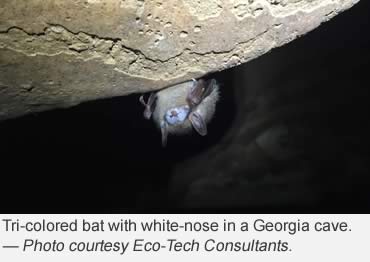By Katrina Morris, Georgia Dept. of Natural Resources
Photo: Georgia DNR's Jackie Beck swabs a bat to check for Pd. — Photo courtesy Katrina Morris.
The past year brought a lot of news about white-nose syndrome, and little of it good.
The fungus that causes white-nose, Pseudogymnoascus destructans or Pd, is being found in more places, from the state of Washington to China. It's no surprise that the impact of WNS, often marked by white growth on the muzzles of hibernating bats and blamed for the death of more than 6 million bats in North America, also is growing.
Surveys this winter in north Georgia revealed that bat numbers have declined by 92 percent in 10 sites monitored since before WNS arrived. DNR biologists can only survey a small number of caves but these likely represent the big picture of what’s happening to bats in the northern part of the state. Preliminary data also shows that the scientists are catching fewer bats in summer.
Elsewhere, University of California at Santa Cruz researchers announced they found Pd throughout China. Some bats had skin lesions characteristic of WNS, although there is no evidence of a population collapse in Asia.
Across the U.S., Nebraska confirmed Pd in that state and Minnesota reported its first case of white-nose. Yet while the westward spread of the fungus was expected on this continent, the announcement in late March that a little brown bat in Washington state had WNS was a bombshell. The previous westernmost site of the disease was 1,300 miles away, in Minnesota.
How did white-nose make it all the way to Seattle? No one knows.
It’s possible the fungus is more widespread than known in the western U.S. It’s also possible that someone accidentally spread it, though there’s no evidence of that. Scientists are trying to identify the source of the fungus, and states in between are scrambling to find new winter sites used by bats that might be transmitting the fungus.
 Is there any good news? Yes.
Is there any good news? Yes.
Some bats are surviving for years in sites infected with WNS. And some species, including the federally endangered gray bat, don’t appear to be developing white-nose, although they carry the fungus.
The U.S. Fish and Wildlife Service named Athens, Georgia-based biologist Pete Pattavina WNS coordinator for the Southeast to guide protection of areas important to bats. Pattavina also is working with Georgia State University researchers on a WNS treatment project in Georgia.
One last piece of good news: Remember, everyone can help bats.
Learn more about bats. Put up a bat house. Find directions by clicking here.
Provide good habitat in your yard. Tell a friend about why bats are important, including as critical pest control for farmers. All will help conserve these small creatures facing the giant-sized threat of white-nose syndrome.
Why Bats Matter
The loss of bats can spur ecological ripples with widespread effects. What do bats do?
• Control insects: A little brown bat can eat its weight in insects in a night; 1 million bats can consume nearly 700 tons a year. Bats save corn farmers worldwide an estimated $1 billion per year in crop damages. This natural pest control also reduces pesticide use.
• Pollinate plants and disperse seeds: More than 300 species of fruit, including mangoes, depend on bats for pollination. Bats are critical to seed dispersal in tropical forests.
• Enrich cave ecosystems: Nutrient-packed guano from cave-roosting bats qualify them as keystone species in these habitats.
• Feed other animals: Wildlife varying from owls to raccoons prey on bats.
• Benefit science: Bat research has led to developments in sonar, vaccines and other areas.
• Serve as indicator species: Population changes can indicate broader ecological issues such as forest loss.
Did You Know?
• There are more than 1,300 bat species, almost 20 percent of the mammal species on Earth.
• Bats are the only mammal that can fly (some other mammals can glide).
— Read more about WNS at https://www.whitenosesyndrome.org/
— Author Katrina Morris leads bat research for DNR’s Nongame Conservation Section.
— Information resources include Bat Conservation International, U.S. Fish and Wildlife Service, U.S. Forest Service.